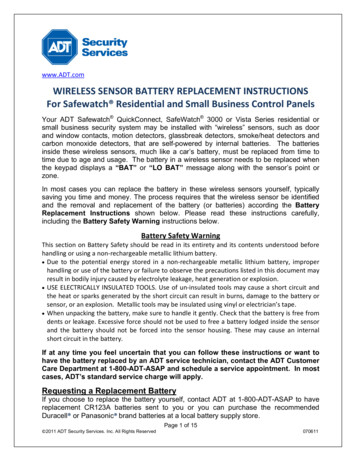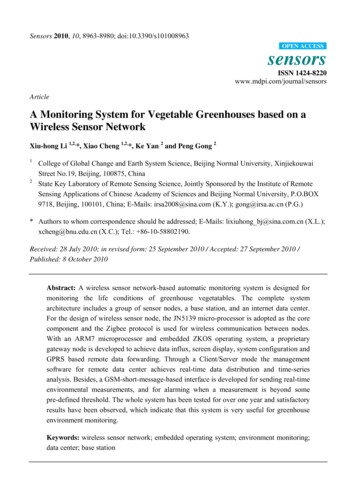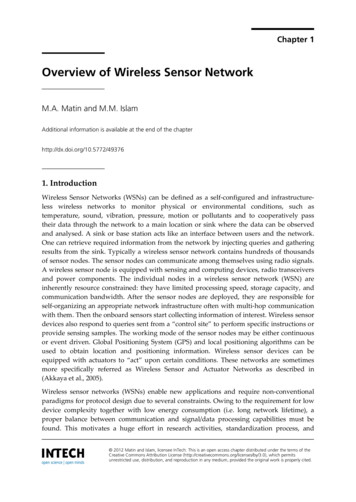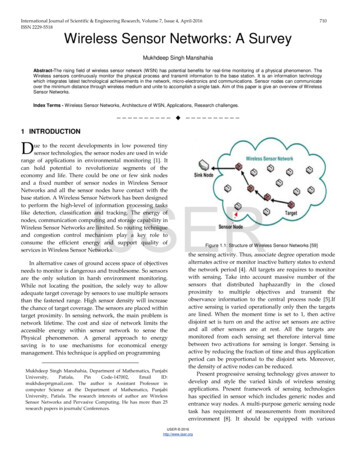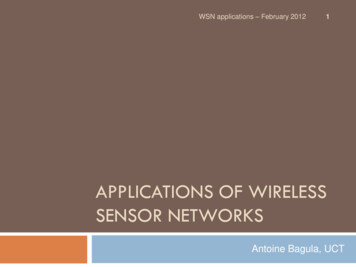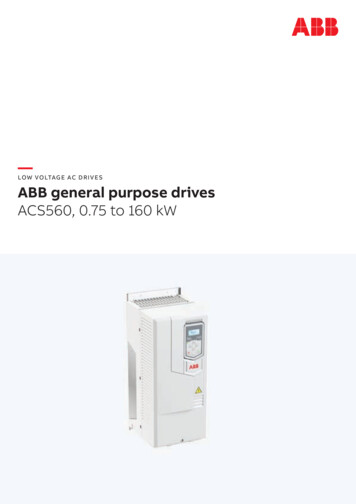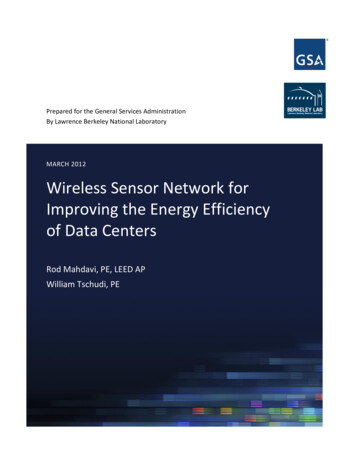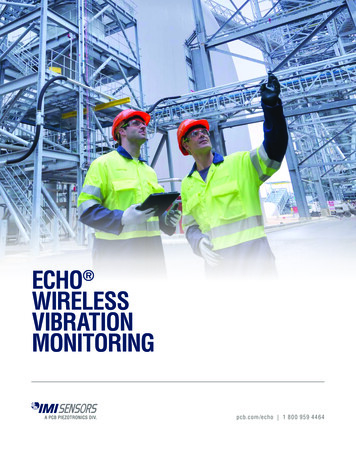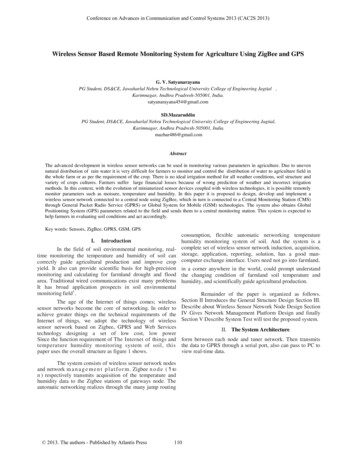
Transcription
Conference on Advances in Communication and Control Systems 2013 (CAC2S 2013)Wireless Sensor Based Remote Monitoring System for Agriculture Using ZigBee and GPSG. V. SatyanarayanaPG Student, DS&CE, Jawaharlal Nehru Technological University College of Engineering Jagtial ,Karimnagar, Andhra Pradresh-505001, India.satyanarayana454@gmail.comSD.MazaruddinPG Student, DS&CE, Jawaharlal Nehru Technological University College of Engineering Jagtial,Karimnagar, Andhra Pradresh-505001, India.mazhar486@gmail.comAbstractThe advanced development in wireless sensor networks can be used in monitoring various parameters in agriculture. Due to unevennatural distribution of rain water it is very difficult for farmers to monitor and control the distribution of water to agriculture field inthe whole farm or as per the requirement of the crop. There is no ideal irrigation method for all weather conditions, soil structure andvariety of crops cultures. Farmers suffer large financial losses because of wrong prediciton of weather and incorrect irrigationmethods. In this context, with the evolution of miniaturized sensor devices coupled with wireless technologies, it is possible remotelymonitor parameters such as moisure, temperature and humidity. In this paper it is proposed to design, develop and implement awireless sensor network connected to a central node using ZigBee, which in turn is connected to a Central Monitoring Station (CMS)through General Packet Radio Service (GPRS) or Global System for Mobile (GSM) technologies. The system also obtains GlobalPositionting System (GPS) parameters related to the field and sends them to a central monitoring station. This system is expected tohelp farmers in evaluating soil conditions and act accordingly.Key words: Sensors, ZigBee, GPRS, GSM, GPSconsumption, flexible automatic networking temperaturehumidity monitoring system of soil. And the system is aIn the field of soil environmental monitoring, real- complete set of wireless sensor network induction, acquisition,time monitoring the temperature and humidity of soil can storage, application, reporting, solution, has a good mancorrectly guide agricultural production and improve crop computer exchange interface. Users need not go into farmland,yield. It also can provide scientific basis for high-precision in a corner anywhere in the world, could prompt understandmonitoring and calculating for farmland drought and flood the changing condition of farmland soil temperature andarea. Traditional wired communications exist many problems humidity, and scientifically guide agricultural production.It has broad application prospects in soil environmentalmonitoring field1.Remainder of the paper is organized as follows.SectionIIIntroduces the General Structure Design Section III.The age of the Internet of things comes; wirelessDescribeaboutWireless Sensor Network Node Design Sectionsensor networks become the core of networking. In order toachieve greater things on the technical requirements of the IV Gives Network Management Platform Design and finallyInternet of things, we adopt the technology of wireless Section V Describe System Test will test the proposed system.sensor network based on Zigbee, GPRS and Web ServicesII. The System Architecturetechnology designing a set of low cost, low powerSince the function requirement of The Internet of things and form between each node and tuner network. Then transmitstemperature humidity monitoring system of soil, this the data to GPRS through a serial port, also can pass to PC topaper uses the overall structure as figure 1 shows.view real-time data.I.IntroductionThe system consists of wireless sensor network nodesand network m a n a g e m e n t p l a t f o r m . Zigbee n o d e ( ton ) respectively transmits acquisition of the temperature andhumidity data to the Zigbee stations of gateways node. Theautomatic networking realizes through the many jump routing 2013. The authors - Published by Atlantis Press110
free of debugging and almost no outer circuit. The system uses32-bit RISC processor Samsung S3C2440 with variousfeatures and peripherals. It’s based on ARM 920T core andsupports embedded Linux, WinCE, VxWorks and otherembedded operating system. All the properties meet therequirements of the remote monitoring system.3) Humidity sensorumidity measurement instruments usually rely onmeasurements of some other quantity such as temperature,pressure, mass or a mechanical or electrical change in asubstance as moisture is absorbed. By calibration andcalculation, these measured quantities can lead to ameasurement of humidity.4) Soil sensorThe soil sensors collect information on soil temperature andsoil moisture in the outdoors environment.Figure. 1. System ArchitectureRunning in the PC, the data acquisition terminal software canrealize the node management, data query, data storage andrelease, and the Web Services have identified by sharing datanetwork technology, finally reach The Internet of Things.The whole system designs good human-machine interface,easy exchange3.III. Design of Wireless Sensor NetworkA. Wireless sensor network node hardware designConsidering thewireless sensornetworkrequirement to implement low cost, low power consumption,high performance and high sensitivity and the antiinterference ability, In this paper, we choose CC2430 chipfrom TI company for Zigbee nodes , SHT15 chip for sensors,and the power part adopts solar power first.1)S3C2440ARM Intelligent Monitoring Center uses Samsung's S3C2440processor as its main controller, the performance andfrequency of which are suitable for real-time video imagecapture and processing applications [2]. Embedded Linuxoperating system and boa embedded web server run on themain controller to manage various types of equipmentsincluding sensor networks, GSM / GPRS dual band module,USB cameras and so on3.B. Zigbee communication protocol realizingThe digital frequency part, the direct sequence spreadspectrum (DSSS) technology, not only can easilyrealize 802.15.4 short-range wireless communicationstandard compatible, and greatly improve the reliability ofwireless communications10. The protocol stack design isprecise and reliable, including very important logy, etc4.In the past, due to the low consumption, we more usedstar topology in the networking. But the coverage and theefficiency will be limited by the structure of the network bystar, and failure of Cluster nodes can lead to the failure of thenetwork structure. Relative to the star network, the scopepreventing ordinary lithium battery power supply time shortand cannot continue ,making a foundation for using the treetopology. of physical of tree network is bigger, the numberof nodes for more. In this paper, we use the solar powersupply.Internal protocol, between layer and layer, realizeinformation communication through the API, APIprovides the interfaces to 802.15.4 protocol stackmanagement and data services11. Direct executive functiondirectly executes those operation codes that realize a MAC;Callback function accesses date through the parameters ofthe function, only is effective during the implementation.These API functions execute in MAC environment.2) Temperature sensorSHT15 is small-sized, calibration, muti-function, intelligentsensor from the company of Switzerland sensiri-on. It canmeasure relative parameters such as temperature,humidity and temperature measuring range is 400C 123.80C, Resolution is 0.1, response time is less than3s. SHT15 is intelligent new sensor with free of calibration,111IV. Design of Network Management PlatformA. Hardware design of gateway nodeThe gateway node, as a information managementand localization of wireless sensor network platform, needhave quicker processing speed and strong informationmanagement functions. In this design, we focus the core
GPRS building wireless sensor network gateways hardware conveniently. There are monitoring and controlling theplatform.maps and historical data query functions, In the specifiedoperating or provisions specified duration, acquisition1) Zigbee stationterminal will upload data to a WEB database server.In this paper, we embed Zigbee coordinator node2) Web Data base serverinto the gateway, as a fully functional devices, collecting allAtosServer runs in the server, being responsible fornodes data. Communication between Coordinator and GPRSis through serial, also can directly communicate with the PC, receiving all the acquisition terminal (regional) data, andrealizing real-time data checking and monitoring4.according to the area code, sets all data in the database.Then it provides a WEB server functions. System adopts2) GPRS/GSMB/S structure; t h e u s e r c a n v i s i t a t a n y t i m e t h r o u g hThis system uses SIM100-E GSM / GPRS dual-band module s p e c i f i c terminal server.for voice transmission, messages and data services. It provides3) Access serverwireless interface and communicates with the ARMPC terminals service program can be used forIntelligent Monitoring Center through the RS232 interface.We write AT commands into the serial device file and control access servers, obtains a latest data of each district atand master WSN dynamic data asthe GPRS module to achieve functions such as the SMS / anytime and anywhere,1MMS mode automatic alarm to the managers when an soon as possible .exception occurs with the field monitoring data3.V. SYSTEM TEST3) The solar energy power supplyA. Test PlanIn this experiment, according to the current,voltage and other data measured from gateway and theIn 800square meters, we distributed sixapplication requirements, we designed the solar powertemperature humidity sensor nodes, each node can achievefor gateway node .using the 12V voltage, experimentsrouting functions. Soil temperature humidity sensor nodeproved the solar power supply system is stable and reliable.is set into soil for 8cm, completes the data collection,4) GPSsending. Then the nodes will be dormant until the next oneIn this Global positioning system (GPS) is used forsampling period.finding the location of agriculture field location.B. Testing ResultThe communication between the nodes in theThe whole arrangement shown below figure 2distance is about 15m, after launching system for 1min,node binding can be completed, forming self-organizingnetworks. When getting to the sampling time, they cancomplete sending data in 10s. query and managementinformation can be got on acquisition terminal, as shown 3Figure. 2. Agriculture monitoring systemFigrure. 3. Acquisition terminal moduleB. Software on the Internet of Things1) Acquisition terminalAcquisition terminal program gets RF data in thegateway based of nodes through a serial port, USB port,then temporarily stores in local, can be checkedVI. Experimental ResultsWe can also send data to the remote server with thestatic IP address through the GPRS; delay shall not exceed1min. Fig. 4 shows the control panels interface of the112
proposed system. The control panel contains three sectionswhich are Sensor Ports, Current Temperature and SetMaximum Temperature. The Sensor Ports set the connectionbetween computer and the wireless temperature sensor. Forcommunication to be done, the end user must select thecommunication port from the drop down menu. Besides, theCurrent Temperature section displays the retrievedtemperature data. There are two types of temperature datawhich are the data retrieved directly from the sensor, and thedata extracted from the database. The upper textbox in thissection contains the former type of the data. This data containsother values than temperature and it changes for every second.For the purpose of this system, this data is sent to the databaseand extracted to generate the temperature value only. Thisextracted temperature value is shown in the lower textbox ofthis section5.Figure. 5. Web GUI for Agricultural environment monitoringServer systemFigure. 4. Soil sensor and temperature sensor control panel interfaceThe data collected from the physical layer is processed byeach manager for storage in the database, and is presented onthe GUI to users via the Web server. Figure 5 below shows aWeb GUI provided to users, where (1) is a result ofmonitoring data, where the data coming in through the sensorsis displayed where this server is installed by the streamingservice through the information manager. (2) is a result of thelocation monitoring service, which shows that the currentlocation data of the collected server system is mapped on themap with red markers. (3) and (4) display environmental andsoil data stored in the database through the sensor manager.Finally (5) shows data acquired from environmental sensors asa graphic form by averaging them6.VII. ConclusionIn the specific application needs of soilenvironmental monitoring system and analysis those problemexisting in monitoring system, we designed andimplemented a wireless sensor network based on the soiltemperature humidity monitoring system. The system canrealize rapidly automatic networking and real-time dataacquisition, transmission, display. With the characteristicsof low cost, low power consumption, flexibility networking,without cabling, friendly interface, etc. Through GPRStechnologies and Web Services technology, we can realizethe function of the data networking, remote monitoring, itshows that the system can meet the requirements of thetemperature and humidity of soil environmental monitoring113
and unified management. In future, we can monitor theground water level using appropriate sensor. Further theresearch could also be enhanced to produce a system that canmonitor the whole weather condition for a large area likestate or country.45-59.[19] Dayang Amenozima Abang Ismail and Kamaruzaman Jusoff,Geospatial Information Technologies for Malaysian Agriculture in theNext Millennium, Seminar on Repositioning Agriculture Industry inthe Next Millennium, 1999.[20] S. Correia, V. Realinho, R. Braga, J. Turégano, A. Miranda, J. Gañan,Development of a Monitoring System for Efficient Management ofAgriculture Resources, Proceeding of the VIII International Congresson Project Engineering, [12][13][14][15][16][17][18]LIU Yumei, ZHANG Changli , ZHU Ping, ”The temperature humiditymonitoring system of soil based on wireless sensor networks “ , 2011IEEE.A. Dhivya, J. Infanta and K. Chakrapani,“Automated AgriculturalProcess Using PLC and ZigBee” Journal of Artificial Intelligence, 2012.Liu Yang, Linying Jiang , Kun Yue ,Heming Pang, “ Design andImplementation of the Lab Remote Monitoring System Based onEmbedded Web Technology”,2010.Khusvinder Gill, Shuang-Hua Yang, Fang Yao, and Xin Lu, “A ZigBeeBased Home Automation System”, MAY 2009.Izzatdin Abdul Aziz, Mohd Hilmi Hasan, Mohd Jimmy Ismail, MazlinaMehat, Nazleeni Samiha Haron, “Remote Monitoring in AgriculturalGreenhouse Using Wireless Sensor and Short Message Service (SMS)”,2008.Jeonghwan Hwang, Changsun Shin, and Hyun Yoe “Study on anAgricultural Environment Monitoring Server System using WirelessSensor Networks”,2010.Zhang xihai, Zhang changli Fang junlong. Smart Sensor Nodes forWireless Soil Temperature Monitoring Systems in PrecisionAgriculture 2009. 237-241Bogena H R, Huisman J A, OberdÊrster C, et al. Evaluation of alow cost soil water contentsensor for wireless networkapplications [J].Journal of Hydrology, 2007, 32-42Li wenzhong Duan chaoyu. ZigBee2007/PRO experiment andpractice of stack. Press of Beihang University, Beijing, 2007George W. Irwin, Jeremy Colandairaj and William G. Scanlon, AnOverview of Wireless Networks in Control and Monitoring,International Conference on Intelligent Computing, Kunming , CHINE(2006), Vol. 4114, 2006, pp. 1061-1072.Tseng Chwan-Lu, Jiang Joe-Air, Lee Ren- Guey, Lu Fu-Ming, OuyangCheng-Shiou, Chen Yih-Shaing and Chang Chih-Hsiang, Feasibilitystudy on application of GSM–SMS technology to field data acquisition,Computers and Electronics in Agriculture, Vol. 53, Issue 1, 2006, pp.45-59.Dayang Amenozima Abang Ismail and Kamaruzaman Jusoff,Geospatial Information Technologies for Malaysian Agriculture in theNext Millennium, Seminar on Repositioning Agriculture Industry inthe Next Millennium, 1999.S. Correia, V. Realinho, R. Braga, J. Turégano, A. Miranda, J. Gañan,Development of a Monitoring System for Efficient Managementof Agriculture Resources, Proceeding of the VIII InternationalCongress on Project Engineering, 2004.Ning Wang, Naiqian Zhang and Maohua Wang, Wireless Sensors inAgriculture and Food Industry - Recent Development and FuturePerspective, Computers and Electronics in Agriculture, Vol. 50, Issue1, 2006, pp. 1–14.Wang Ping, Wang Zheng. Design and Implementation of OpenComputer Lab Monitoring and Management System [J]. Computerand Modernization ,2007,11:125-128.Jing Li, Yong Xu. Remote Monitoring Systems Based on EmbeddedDatabase [C]. Third International Conference on Genetic andEvolutionary Computing.2009:381-384.George W. Irwin, Jeremy Colandairaj and William G. Scanlon, AnOverview of Wireless Networks in Control and Monitoring,International Conference on Intelligent Computing, Kunming , CHINE(2006) , Vol. 4114, 2006, pp. 1061-1072.Tseng Chwan-Lu, Jiang Joe-Air, Lee Ren- Guey, Lu Fu-Ming, OuyangCheng-Shiou, Chen Yih-Shaing and Chang Chih-Hsiang, FeasibilityStudy on application of GSM–SMS technology to field data acquisition,Computers and Electronics in Agriculture, Vol. 53, Issue 1, 2006, pp.114
including sensor networks, GSM / GPRS dual band module, USB cameras and so on3. 2) Temperature sensor IV. Design of Network Management Platform SHT15 is small-sized, calibration, muti-function, intelligent sensor from the company of Switzerland sensiri-on. It can measure relative parameters such as temperature,

